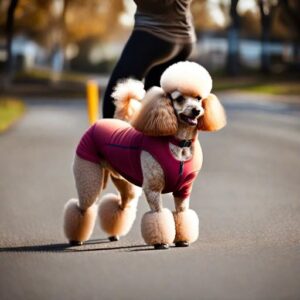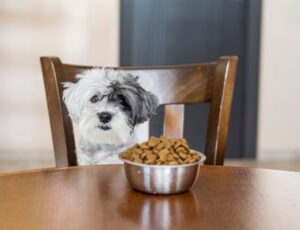Introduction
Mini Poodles are an attractive and adaptable breed of dog that come in three sizes: standard, miniature, and toy. Standard figures are over 15 inches tall, Miniatures are at least 15 inches tall, and Toys are no taller than 10 inches. Each kind has a distinctive structure and dimensions.
Mini Poodles are frequently seen at dog shows with the intricate Continental clip, but the majority of pet owners prefer the more straightforward Sporting clip. Poodles have a lot of energy, are active, and are intelligent, with the Standard being the finest all-around athlete. All Poodles can be successfully taught.

History of mini poodle
Germany, where the name “pudelin” means to splashing in water, is where the Poodle, the French nation’s dog, first gained notoriety as a duck hunter. Non-sporting Standard Poodles have a clean, curly coat, exceptional swimming skills, and astounding intellect.
In the early years of the breed, the colourful display coat served a useful purpose by shielding sensitive parts from the cold. The pompons are the spherical tufts on the legs, hips, and tip of the tail.The aristocrats of France, and subsequently all of Europe, favoured elegant Poodles (Mini Poodle) of the Standard and Miniature kinds. Poodles have long been connected to the history of the European circus because of their flamboyant appearance and trainability.

The Poodle received additional job as a truffle hunter thanks to her outstanding nose.The Toy (Mini Poodle) was initially produced in America in the early 20th century as a companion dog for city dwellers. The Standard was bred down to the Miniature. Each variety’s well-bred individuals are identical duplicates of one another and are bred to the same standard.
The Breed Standard
A definition of the ideal dog of each recognised breed, originally established by a parent breed organisation and recognised formally by national or international organisations, to serve as an ideal against which dogs are judged at shows.
Official Poodle Breed Standard
With the exception of heights, the Poodle (Mini Poodle) Standard is the same for the Standard and Miniature kinds.
General Appearance: Carriage and Condition
That of a very energetic, sharp-witted, and elegant-appearing dog with a square build and good proportions that moved firmly and carried himself with pride.
The Poodle has a particular air of distinction and respect about him that is unique to himself since he is properly trimmed in the traditional manner and well groomed.

Size, Proportion, Substance:
Size: At the tallest point of the shoulders, the Standard Poodle measures more than 15 inches. Any Poodle that is 15 inches or less in height will be disqualified from the Standard Poodle class of competition.
The Miniature Poodle has a minimum height of more than 10 inches and a maximum height of 15 inches or less at the highest point of the shoulders. Any Poodle that measures more than 15 inches or less than 10 inches at the highest point of the shoulders will not be allowed to compete as a Miniature Poodle.
The height of the Toy Poodle’s shoulders is 10 inches or less. Any Poodle that is classified as a Toy Poodle and measures more than 10 inches at the highest point of the shoulders will be excluded from competition.
When all other factors are equal and the Toy Poodle is unquestionably a Toy Poodle and the Miniature Poodle is unquestionably a Miniature Poodle, both in balance and proportion for the Variety, diminutiveness must be the decisive element.

Proportion – Measured from the breastbone to the tip of the rump, the length of the body is almost equal to the height measured from the highest point of the shoulders to the ground. This ensures the desired square-built look.
Substance – The forelegs and hindlegs are both proportionately large for a dog in terms of bone and muscle.
Head and look:
(a) Eyes: Very dark, oval-shaped, spaced-distant eyes that form an alert, perceptive look. Eyes that are big, projecting, round, or extremely light are a major flaw.
(b) Ears: near to the head, positioned at or just below eye level. The ear leather is long, broad, and heavily feathered; yet, the length of the ear fringe shouldn’t be excessive.
(c) Skull: Slightly rounded with a distinct but minor stop. Flat muscles and cheekbones.
roughly the same as the length of the muzzle from the occiput to the stop.
(d) Muzzle: Long, straight, and beautiful muzzle with little chiselling behind the eyes. strong without being smarmy. A firm enough chin prevents snippiness. Lack of chin is a serious flaw. Strong, white, and equipped with scissors teeth Undershot, overshot, and wry mouth are serious flaws.

Neck, Topline, and Body: The neck is strong, well-proportioned, and long enough to allow for a high and respectable head carriage. throat skin is tight. From powerful, finely muscled shoulders, the neck rises. Large flaw: sheep neck. With the exception of a little depression slightly behind the shoulder, the topline is flat, neither sloping nor roached, from the highest point of the shoulder blade to the base of the tail.
Body:
- (a) Deep and a little broad in the chest, with well-sprung ribs.
- (b) The loin is short, wide, and musculoskeletal.
- (c) A straight, high, carried up tail that has been docked long enough to ensure a balanced appearance. Major error: carried over the back, curled, or put low.
Shoulders: A significant flaw in the design is the steep shoulder, which is not parallel to the shoulder blade. Despite this, the shoulder blade remains straight and parallel, demonstrating strong muscles. The feet are small, oval, and do not bend.

Hindquarters: The forequarters’ angulation is balanced by the hindquarters’. Straight and parallel hindlegs when viewed from behind. The femur and tibia are almost the same length, the hock to heel is short, and the bones are perpendicular to the ground. The muscles are broad in the area of the well-bent stifles. The back toes barely trail the apex of the rump when standing. Significant error: cow hocks.
Coat: The English Saddle and Continental clips are used by Poodles to shave their face, neck, feet, and forelegs. The English Saddle clip leaves puffs on the forelegs and base of the tail, while the Continental clip shaves the face, throat, feet, and base of the tail, leaving a short blanket of hair. The entire shaved foot is visible, while the rest of the body can be sculpted for balance.

Color: Poodles have coats that are uniformly solid at the skin and come in a range of colours, including blues, greys, silvers, browns, café au laits, apricots, and creams. Natural differences are tolerated even though transparent colours are preferable. Espresso and brown Poodles have dark amber eyes, dark toes, and lips that are liver in colour. Apricots have amber eyes, liver-colored eye rims, and lips.
Gait: Simple trot with a light, springy motion and a powerful hindquarters push. carried up by the head and tail. It’s crucial to move with ease and soundness.
Temperament: The Poodle exudes a sense of distinction and dignity that is unique to himself. He is also quite energetic and bright. Shyness or sharpness is a serious flaw.

Major Defects: Any glaring departure from the desirable traits outlined in the breed standard.
Disqualifications: Size – A dog that is either over or under the set height limitations will be disqualified.
Clip: Any dog with a clip that is different from those mentioned under coat is rejected.
Particolors: The coat of a parti-colored dog is made up of two or more colours rather than an even solid colour at the skin’s surface. Dogs with partial colours will not be considered.
Cost per Point: General demeanour, disposition, mannerisms, and condition 30
teeth, ears, eyes, and facial expression 20
20 Body, neck, legs, feet, and tail 20 Gait 20
“Coat,” “colour,” and “texture” 10
Approved August 14, 1984
Reformatted March 27, 1990
What to Expect When Taking Care of a Miniature Poodle
The duty of dog ownership goes beyond mere luxury. They deserve far more because they depend on us for food and shelter at the very least. When you bring a dog into your life, you must be aware of the commitment that comes with dog ownership.
Health
Miniature Poodles (mini poodle) are more susceptible to health issues like eye disorders and epilepsy, which are prevalent in breeding stock. These issues can lead to long, happy lives for Poodles. Breeders are responsible for testing all breeding stock for these health issues, ensuring the well-being of Poodles.

The National Breed Club has advised the following health tests:
- Analysis of the patella
- Examining the hip
- Evaluation by an ophthalmologist
- DNA test for PRA-rcd4 (Progressive Retinal Atrophy, Rod-Cone Dysplasia 4)
- PRCD (PRA-prcd, PRCD) – DNA Test for Progressive Retinal Atrophy
- DNA Test for Von Willebrand Disease I
Grooming
To prevent your Poodle’s coat from matting, you must learn how to brush him every day, unless you intend to keep him groomed in a short trim. A full-coated Poodle’s hair will mat close to the roots if you do not brush and comb it all the way down to the skin. In this case, you will need to shave the Poodle to start over with new growth. The Poodle is typically kept shorter by pet owners.

While some dog owners opt to take their dogs to a professional dog groomer for a wash, grooming, and nail cut every four to six weeks, others choose to learn how to perform this clipping and trimming themselves. People with allergies might consider this breed because of its comparatively non-shedding coat.
Exercise
Mini Poodles, regardless of size, are extremely energetic dogs who need daily exercise to keep up with their high level of energy. Poodles love to be busy and are eager for any form of action. Most Poodles enjoy being in the water and swimming is a terrific kind of exercise for them. Throwing toys, sticks, or balls for them will exercise both their mind and body as they were bred as retrieving dogs. They also enjoy taking their human on lengthy walks or jogs.

Training
Highly clever and simple to train, mini poodles. A range of canine activities, including as agility, obedience, and tracking, are enjoyed and excelled at by these intelligent, elegant, and nimble dogs. Additionally to competing in dock diving and retriever hunt events, they are exceptional water retrievers. Due to their high levels of people orientation, poodles are eager to please their owners when training sessions are enjoyable and rewarding. Make sure your requests are consistent throughout.

Nutrition
Whatever mini Poodle size has your heart, he should thrive on a premium dog food, whether it’s made commercially or at home under the guidance and consent of your vet. Any diet should be suitable for the age of the dog (puppy, adult, or senior). So keep an eye on your dog’s calorie intake and weight as certain dogs are prone to obesity. Although offering too many treats might lead to obesity, they can be a useful training assistance. Find out which meals from humans are safe for dogs and which are not. If you are worried about your dog’s nutrition or weight, speak to your veterinarian. Fresh, clean water must always be accessible.

Lifespan of a mini poodle
These little puppies/mini poodle enjoy a long life if they are given good care. For this, their food is crucial. These canines often range in age from 10 to 19 years. Small poodles are highly energetic canines. As a result, they require a lot of activity to be healthy.

